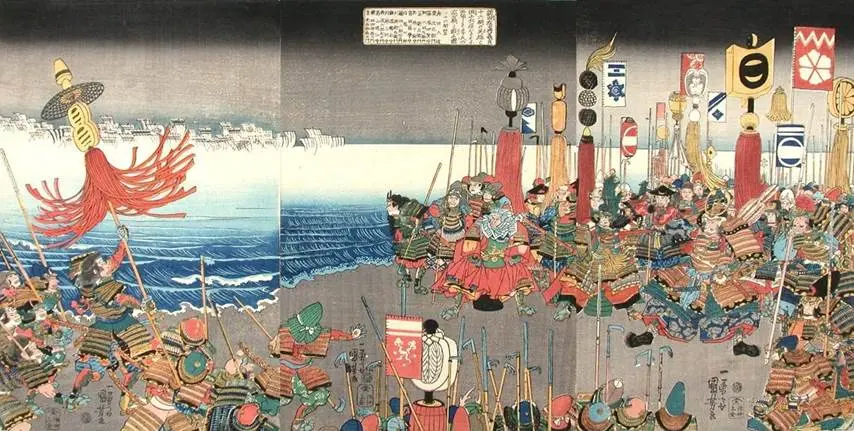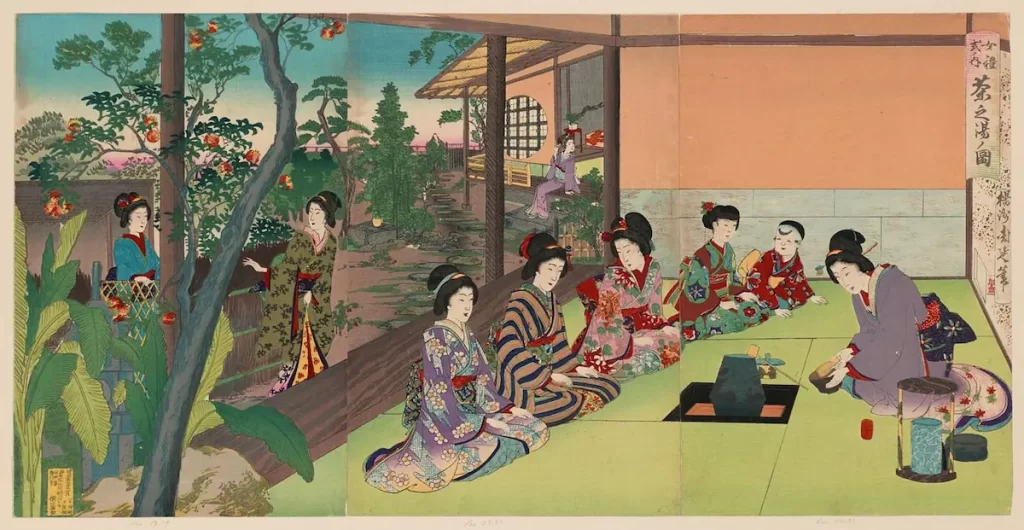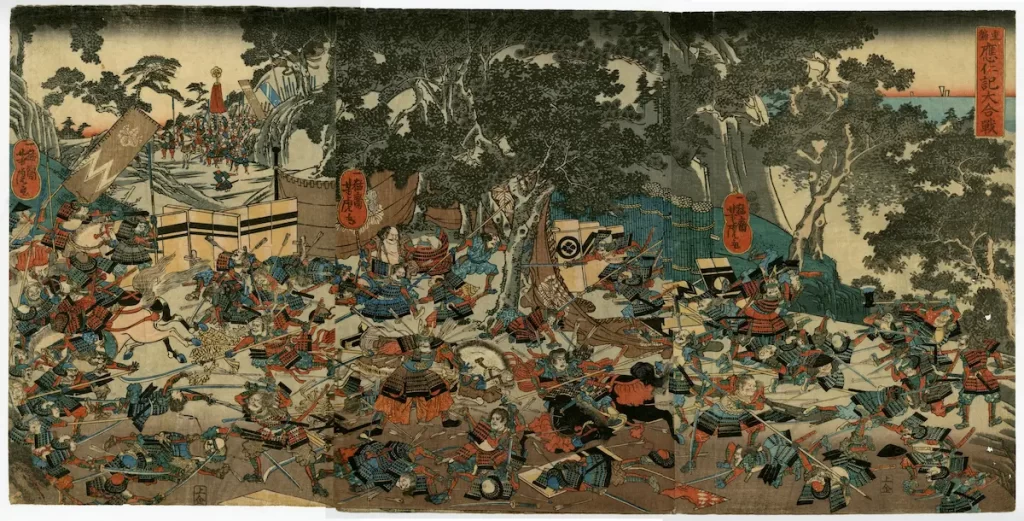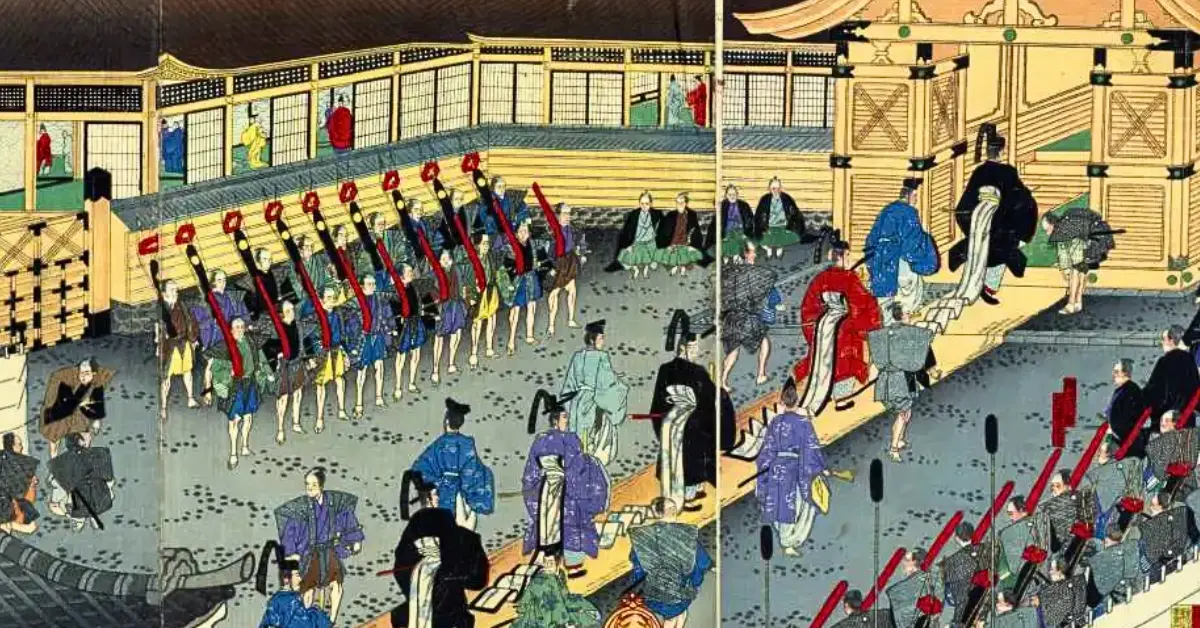From 1336 to 1573, the Muromachi Period was marked by the formation of the Ashikaga shogunate and the rise of feudal lords known as daimyos. This era followed the Kamakura Period and the brief Kenmu Restoration.
In this period, feudal lords gained prominence, and key military events, like the Onin War, played a crucial role. Cultural arts such as the noh theater and tea ceremony also reached new heights of refinement.
These developments set the stage for Japan’s unification under the Tokugawa shogunate. Let us take a closer look at the Muromachi Period.
Key Takeaways
- The Muromachi or Ashikaga Period (1336-1573) came with the fragmented Nanboku-cho period. The Ashikaga shogunate brought about profound changes in Japan’s political landscape.
- Cultural growth flourished during this period, influenced by Zen Buddhism. It was a time that celebrated the tea ceremony, noh theatre, and ink wash painting, underpinned by the elegant Higashiyama culture of Ashikaga Yoshimitsu.
- Feudal lords or daimyos gained more power, particularly after the Onin War. Regional autonomy increased with the weakening of central shogunate control.
- Significant military conflicts include the Onin War and battles like Kawagoe and Okehazama. The introduction of firearms intensified these conflicts. These marked the transition into the chaotic Sengoku period.
- The decline of the Ashikaga shogunate and the later rise of Oda Nobunaga initiated the transition to the Azuchi-Momoyama Period. Nobunaga’s military innovations paved the way for Japan’s eventual unification.
Brief Overview of the Muromachi Period (1336-1573)
The Muromachi Period, a transformative chapter in Japanese history, spanned from 1336 to 1573. It emerged on the heels of the turbulent Nanboku-cho period, or the Northern and Southern Courts period, which endured from 1336 to 1392.
During this earlier period, the Northern and Southern Courts vied for the imperial power. The balance of power within feudal Japan eventually tilted to the Northern Court of Ashikaga Takauji, establishing the Ashikaga shogunate.
Named after the Muromachi district in Kyoto, the seat of the Ashikaga shogunate, this era is renowned for its significant internal strife. The most notable conflict was the Onin War.
The war brought about the Sengoku period with extensive civil war and significant societal disruption.

Muromachi Period Society and Culture
The Muromachi period was also a period of significant cultural development.
Influenced greatly by Zen Buddhism, this era saw the flourishing of arts such as the tea ceremony, noh theatre, renga poetry, and ink wash painting. Ashikaga Yoshimitsu promoted the Higashiyama culture which exemplified the aesthetic refinement of the period.
Japan’s interactions with China also intensified. Chinese goods and ideas influenced the Japanese culture.

Yet, this period also saw social unrest. Activities of the Ikki (league of warriors) and Jizamurai (local samurai) challenged the traditional feudal order.
Rise of Feudal Lords (Daimyos)
Powerful feudal lords (daimyos) who controlled vast swaths of land became increasingly autonomous. Influential daimyo families, like the Uesugi, Takeda, and Mori clans, emerged as the Ashikaga shogunate’s grip weakened.
These clans fought among themselves and against the central authority. Japan became fragmented with smaller, competing domains.
Key Clashes and Conflicts
This era was riddled with notable clashes and conflicts. The Onin War (1467-1477) was a significant catalyst for the Sengoku period. Kyoto turned into a battlefield, and there was widespread chaos.
Other significant battles include the Battle of Kawagoe (1546), where the Uesugi clan was defeated, and the Battle of Okehazama (1560), where Oda Nobunaga defeated the Imagawa clan.
Firearms, introduced by the Portuguese, revolutionized Japanese warfare during this period.

Transition to the Azuchi-Momoyama Period
The transition to the Azuchi-Momoyama period was marked by the decline of the Ashikaga shogunate. The last shogun, Ashikaga Yoshiaki, was ousted by Oda Nobunaga, who embarked on a quest to unify Japan.
Nobunaga’s innovative military strategies and use of firearms set the stage for the eventual unification of Japan. His successor, Toyotomi Hideyoshi, continued the unification process after his assassination.
The period peaked with the rise of Tokugawa Ieyasu, who would eventually establish the Tokugawa shogunate. A long era of peace and stability arrived in Japan.
Frequently Asked Questions
What was the Muromachi period known for?
The Muromachi period was known for the rise of the Ashikaga shogunate and feudal lords. It was a time of cultural blossoming, especially in arts like the tea ceremony and noh theater.
How did the Muromachi Period influence Japanese art and culture?
The Muromachi period greatly influenced Japanese culture, promoting Zen Buddhism and the arts. It saw the development of unique styles in painting, poetry, and theater.
What caused the Onin War, and what were its consequences?
The Onin War was caused by a power struggle within the Ashikaga shogunate. Its consequences included widespread destruction in Kyoto and the start of the Sengoku period.
What was the most violent era in Japan?
The Sengoku period (1467–1615), emerging from the Muromachi period, is considered the most violent era in Japan. It was marked by near-constant military conflict and social upheaval.
What were the major battles and conflicts of the Muromachi Period?
Major conflicts included the Onin War, the Battle of Okehazama, and the Battle of Kawagoe. These battles significantly influenced the political landscape of Japan.
Why did the Muromachi period end?
The Muromachi period ended due to the decline of the Ashikaga shogunate. Internal conflicts and the rise of powerful daimyos like Oda Nobunaga led to its fall.
Further Reading
- The Cambridge History of Japan: Volume 3 (Medieval Japan)


